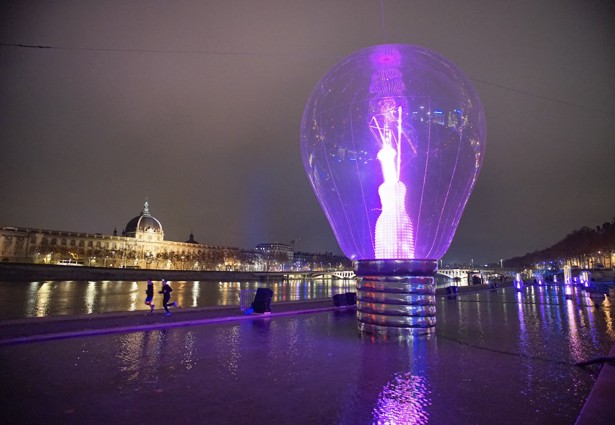
Silicon Valley often finds itself faced with a difficult question, one that’s asked so often it’s practically a parlor game: Are we in a tech bubble? In other words, is the volume of money pouring into technology companies sustainable, or are we on the brink of a dot-com-esque collapse?
In The Atlantic’s recent survey of dozens of tech thinkers, entrepreneurs, and executives, there was a curious response to this question that came up more than once. This isn’t a bubble, more than one respondent insisted, in the same way that there wasn’t an electricity bubble a century ago: People might have said it was a bubble at the time, but they were wrong.
That’s a compelling comparison, and it requires a bit of unpacking to properly assess. Was there an electricity bubble? Did people at the time even claim there was?
To find the answer, we have to travel back to the 1870s, when the inventors Charles Brush and Thomas Edison first demonstrated arc lighting and incandescent bulbs. There was an immediate economic blow to the gas companies, which saw their stock prices plummet, then recover, and eventually grow as they shifted their focus to heating and cooking technologies.
For decades, uncertainty about what electricity might do to the market prevailed. “With regard to our public lighting,” the physicist John Tyndall said in a speech in 1879, “I strongly lean to the opinion that the electric light will at no distant day triumph over gas. I am not so sure that it will do so in our private houses. As, however, I am anxious to avoid dropping a word here that could influence the share market in the slightest degree, I limit myself to this general statement of opinion.”
Electricity created its own economic frenzy distinct from gas. “There were many companies in the 1880s with shakeout and consolidation in the 1890s,” said David Nye, the author of the book Electrifying America. “A bit like the early word-processing market of the 1970s and early 1980s, with many competing and incompatible systems that converged since.”
Which means the dawn of electricity was an uncertain time for the venture capitalists of the day, even though its success now, in retrospect, seems to have been inevitable. The trajectory wasn’t so obvious in real-time. In the 1890s, for instance, investors dumped their money into electric streetcars, but most early systems failed. “Hope is sometimes as baseless as fear,” The New York Times wrote in a wide-ranging column about the global economy in 1879, “Both may be fostered by occurrences that are untrustworthy as guides of conduct.” And though much of the debate among stakeholders at the turn of the century focused on which would win out—gas versus electric—both technologies would end up improving and thriving in different ways over time.
“I do not think it was a bubble situation, because the market for electricity did in fact grow rapidly, as it did for gas, too, which gradually switched over to being used primarily for heating rather than lighting,” Nye told me. “So, there were stock gyrations up and down, and there were many now-forgotten companies that disappeared in mergers or went bankrupt, but there was not a bubble like the famous tulip craze in Holland.”
In other words, not every company that tried to get in on electricity would survive—in fact, many failed spectacularly—but, more broadly over time, the technology would be transformative on multiple levels. And that’s another reason why electricity resonates as a comparison to the technology industry today. The adoption of electricity made a profound difference in people’s lives at both the individual and society-wide level, by itself and because of how it enabled further technological advances. In Electrifying America, for instance, Nye points out that when electric trolleys became popular, they led Americans to other electrified pastimes—nickelodeon movie theaters and amusement parks that dazzled patrons with bright lights and rides powered by electricity.
“On the other hand, for those who lived in those times, the market was hardly stable, especially in the 1890s when there was a major depression,” Nye told me, “but this affected all businesses, not just those supplying lighting.”
The larger point is that once electricity arrived, there was no going back. In 1910, about 10 percent of the homes in America had electricity. By 1930, 70 percent did. Yet the rise of electricity didn’t mean that every businessperson who was bullish about the technology’s promise would benefit. And for people who invest in Silicon Valley today, the same thing could be said about mobile. Many, perhaps even most, startups will fail. But the larger social changes that smartphones have wrought will persist.
“We are in the first minute of the first hour of a massive technology cycle,” said Andrew Thompson, the CEO of Proteus Digital Health, in response to our survey. “I have no doubt in 1920 people were saying that electricity was causing a tech bubble. But that did not stop the transformation that followed. The incredible power of a building where you could ‘plug in’ is being multiplied many times by the opportunities created by a mobile device where you can ‘log on.’”
Are we in a tech bubble? This isn’t actually a question you can answer with certainty until the answer turns out to be “yes.” And by then, there are usually more pressing questions to address. If the history of technology teaches us anything, it’s arguable this: No one stays on top forever. “The reduction [in stock values] will be resisted of course,” the Times wrote in 1879, “But sooner or later it will come... Thoughtful investors do not ignore this contingency in their appraisal of relative values.”